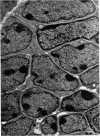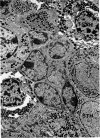Abstract
An electron microscopical study has been carried out to evaluate the effect of neonatal thymectomy on the hypophysis of germ-free mice at different times after the operation. The results fully confirm the previous findings in neonatally thymectomized, conventional mice. Also neonatal thymectomy in germ-free mice results in degranulation of growth hormone-producing cells in the anterior pituitary gland. A large number of these cells show an enlarged endoplasmic reticulum with formation of cisternae and loss of hormone granuli. This alteration of growth hormone-producing cells is similar to that observed in other cells of the hypophysis after removal of other target glands such as thyroid or gonads. The changes in the growth hormone-producing cells in neonatally thymectomized germ-free mice occur even in the first days after birth, when the number of differentiated growth hormone-producing cells is still very low.
Some thymectomized germ-free mice showed symptoms of the wasting syndrome but the alterations in their hypophysis were not more pronounced than those observed in thymectomized germ-free but nonwasting mice. The data fit well our suggestion that the perinatal thymus is under hypophysial control and that immunological maturation depends on endocrine function.
Full text
PDF












Images in this article
Selected References
These references are in PubMed. This may not be the complete list of references from this article.
- EAST J., PARROTT D. M., CHESTERMAN F. C., POMERANCE A. THE APPEARANCE OF A HEPATOTROPHIC VIRUS IN MICE THYMECTOMIZED AT BIRTH. J Exp Med. 1963 Dec 1;118:1069–1082. doi: 10.1084/jem.118.6.1069. [DOI] [PMC free article] [PubMed] [Google Scholar]
- FARQUHAR M. G., RINEHART J. F. Cytologic alterations in the anterior pituitary gland following thyroidectomy: an electron microscope study. Endocrinology. 1954 Dec;65(6):857–876. doi: 10.1210/endo-55-6-857. [DOI] [PubMed] [Google Scholar]
- FARQUHAR M. G., RINEHART J. F. Electron microscopic studies of the anterior pituitary gland of castrate rats. Endocrinology. 1954 May;54(5):516–541. doi: 10.1210/endo-54-5-516. [DOI] [PubMed] [Google Scholar]
- Fabris N., Pierpaoli W., Sorkin E. Hormones and the immunological capacity. 3. The immunodeficiency disease of the hypopituitary Snell-Bagg dwarf mouse. Clin Exp Immunol. 1971 Aug;9(2):209–225. [PMC free article] [PubMed] [Google Scholar]
- Fabris N., Pierpaoli W., Sorkin E. Hormones and the immunological capacity. IV. Restorative effects of developmental hormones or of lymphocytes on the immunodeficiency syndrome of the dwarf mouse. Clin Exp Immunol. 1971 Aug;9(2):227–240. [PMC free article] [PubMed] [Google Scholar]
- Keast D. A simple index for the measurement of the runting syndrome and its use in the study of the influence of the gut flora in its production. Immunology. 1968 Aug;15(2):237–245. [PMC free article] [PubMed] [Google Scholar]
- MCINTIRE K. R., SELL S., MILLER J. F. PATHOGENESIS OF THE POST-NEONATAL THYMECTOMY WASTING SYNDROME. Nature. 1964 Oct 10;204:151–155. doi: 10.1038/204151a0. [DOI] [PubMed] [Google Scholar]
- Pierpaoli W., Baroni C., Fabris N., Sorkin E. Hormones and immunological capacity. II. Reconstitution of antibody production in hormonally deficient mice by somatotropic hormone, thyrotropic hormone and thyroxin. Immunology. 1969 Feb;16(2):217–230. [PMC free article] [PubMed] [Google Scholar]
- Pierpaoli W., Fabris N., Sorkin E. Developmental hormones and immunological maturation. Ciba Found Study Group. 1970;36:126–153. [PubMed] [Google Scholar]
- Pierpaoli W., Sorkin E. Cellular modifications in the hypophysis of neonatally thymectomized mice. Br J Exp Pathol. 1967 Dec;48(6):627–631. [PMC free article] [PubMed] [Google Scholar]
- Pierpaoli W., Sorkin E. Effect of gonadectomy on the peripheral lymphatic tissue of neonatally thymectomized mice. Br J Exp Pathol. 1968 Jun;49(3):288–293. [PMC free article] [PubMed] [Google Scholar]
- Pierpaoli W., Sorkin E. Effect of growth hormone and anti-growth hormone serum on the lymphatic tissue and the immune response. Antibiot Chemother. 1969;15:122–134. doi: 10.1159/000386777. [DOI] [PubMed] [Google Scholar]
- Pierpaoli W., Sorkin E. Hormones and immunologic capacity. I. Effect of heterologous anti-growth hormone (ASTH) antiserum on thymus and peripheral lymphatic tissue in mice. Induction of a wasting syndrome. J Immunol. 1968 Nov;101(5):1036–1043. [PubMed] [Google Scholar]
- Reed N. D., Jutila J. W. Wasting disease induced with cortisol acetate. I. Studies in germ-free and conventionally reared mice. J Immunol. 1967 Jul;99(1):238–245. [PubMed] [Google Scholar]
- SIPERSTEIN E., NICHOLS C. W., Jr, GRIESBACH W. E., CHAIKOFF I. L. Cytological changes in the rat anterior pituitary from birth to maturity. Anat Rec. 1954 Mar;118(3):593–619. doi: 10.1002/ar.1091180308. [DOI] [PubMed] [Google Scholar]
- WILSON R., SJODIN K., BEALMEAR M. THE ABSENCE OF WASTING IN THYMECTOMIZED GERMFREE (AXENIC) MICE. Proc Soc Exp Biol Med. 1964 Oct;117:237–239. doi: 10.3181/00379727-117-29545. [DOI] [PubMed] [Google Scholar]









